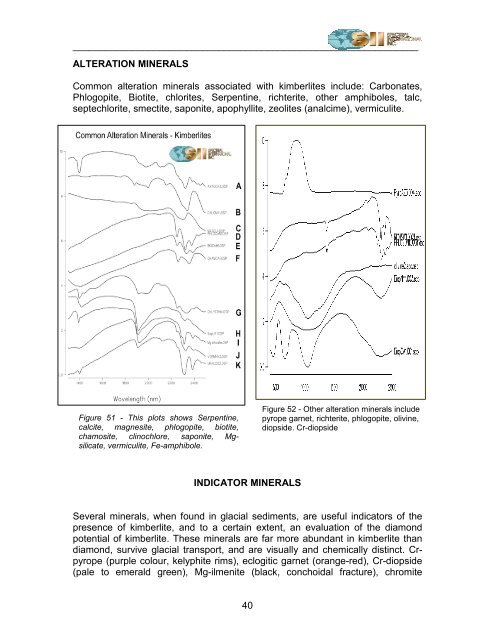An overview of vis-nir-swir field spectroscopy - Spectral International
An overview of vis-nir-swir field spectroscopy - Spectral International
An overview of vis-nir-swir field spectroscopy - Spectral International
You also want an ePaper? Increase the reach of your titles
YUMPU automatically turns print PDFs into web optimized ePapers that Google loves.
________________________________________________________________<br />
ALTERATION MINERALS<br />
Common alteration minerals associated with kimberlites include: Carbonates,<br />
Phlogopite, Biotite, chlorites, Serpentine, richterite, other amphiboles, talc,<br />
septechlorite, smectite, saponite, apophyllite, zeolites (analcime), vermiculite.<br />
Figure 51 - This plots shows Serpentine,<br />
calcite, magnesite, phlogopite, biotite,<br />
chamosite, clinochlore, saponite, Mgsilicate,<br />
vermiculite, Fe-amphibole.<br />
INDICATOR MINERALS<br />
Several minerals, when found in glacial sediments, are useful indicators <strong>of</strong> the<br />
presence <strong>of</strong> kimberlite, and to a certain extent, an evaluation <strong>of</strong> the diamond<br />
potential <strong>of</strong> kimberlite. These minerals are far more abundant in kimberlite than<br />
diamond, survive glacial transport, and are <strong>vis</strong>ually and chemically distinct. Crpyrope<br />
(purple colour, kelyphite rims), eclogitic garnet (orange-red), Cr-diopside<br />
(pale to emerald green), Mg-ilmenite (black, conchoidal fracture), chromite<br />
40<br />
Figure 52 - Other alteration minerals include<br />
pyrope garnet, richterite, phlogopite, olivine,<br />
diopside. Cr-diopside


